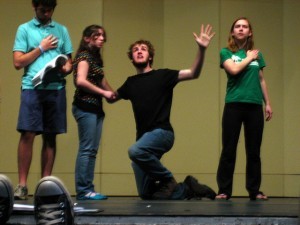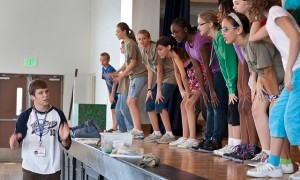Gary Neal Hansen's Blog, page 46
January 1, 2016
St Basil the Great

 It is New Year’s Day. Most of us are celebrating with a quiet day off. But there are two holy days today that I’m guessing most of my readers are not giving too much attention to.
It is New Year’s Day. Most of us are celebrating with a quiet day off. But there are two holy days today that I’m guessing most of my readers are not giving too much attention to.
The first is “The Circumcision of Jesus.” It is the eighth day of Christmas, and the eighth day is when a Jewish boy would be …
Well, you know. Our Lord fully identified with the human experience.
The second is the feast day of St Basil of Caesarea (330-379), at least in Eastern Orthodoxy. He’s “St Basil the Great” to East and West — and for good reason.
St Basil the Great
Let’s take just one topic on which he was monumentally influential: the Holy Spirit. If you have a decent understanding of the Holy Spirit, you can thank St. Basil for it.
You may well take it for granted that the Holy Spirit is truly God, one of the three Persons of the Trinity. But it wasn’t always entirely clear in the Church’s teachings.
In retrospect the Scriptures may seem perfectly clear on the topic, but it is only in retrospect.
The Back Story
Here’s the deal: Early on Christians praised the God they found in the Bible and in their own living faith. They praised the Father, the Son, and the Holy Spirit, and they knew that there is only one God. But the details were a tad fuzzy.
Then came the 4th century, the period when Basil was born. Christianity was becoming legal and socially acceptable. It was no longer just for the marginalized. People like Basil who had the best education in the world were coming to salvation in Christ.
And they brought their skillful minds with them. They began thinking about the Bible and worship and theology in much more careful ways.
Big questions began to arise. Everything about the Trinity had to be thought through, and argued over, in detail.
First it was about the Son of God. Arianism said the Son was created by the Father. Just before Basil was born the Council of Nicaea said no, the Son is eternally the Son and the Father is eternally the Father; they are “of the same substance,” “true God from true God.”
The Holy Spirit
Then came the Holy Spirit. As soon as the deity of the Son was settled (sort of — the Arian party was in power off and on for a very long time) questions arose about whether the Holy Spirit was really God. Or really as much God as the Father and the Son.
It was St Basil the Great who wrote the first book-length discussion of the Holy Spirit.
First he used arguments much like those used earlier to defend the divinity of the Son.
Then he explored the whole range of biblical discussion on the Spirit.
And then he did a very clever thing: He pointed out that from the very earliest days, Christians have, in worship and prayer, praised the Spirit exactly as they praise the Father and the Son. To say the Spirit was not God like the Father and Son are God would be to say all of Christianity had always been wrong in the way they related to God.
Yes, tradition had a big voice in this — tradition that embodied Apostolic teaching and truly universal practice.
Worship, Community, Doctrine, Compassion
Besides basic doctrine, St. Basil was influential on other important fronts:
He cared about worship, writing one of the primary liturgies still in use in the Orthodox tradition.
He cared about community, organizing monastic life for both men and women, shaping it to the present day.
He cared about the spiritual and theological health of the larger Church: as an Archbishop he put in place many Orthodox bishops, helping the Nicene party eventually win the day.
And he was compassionate, working for the welfare of the poor.
How I wish we had more like St. Basil serving the Church today. May he be a role model for all of us who lead God’s people.
The post St Basil the Great appeared first on Gary Neal Hansen.
December 30, 2015
Reveling in the Mystery of Christmas

 cc by Ted-sa 2.0
cc by Ted-sa 2.0I hope that this finds you reveling in the mystery of Christmas. We are only halfway through the 12 days, so let’s keep at it.
Pour yourself a mug of eggnog or mulled wine and think about it:
The eternal God has taken human flesh and dwells among us!
That is far too big a miracle to be done with in a day.
Reveling in the Mystery of Christmas
If you want something to nudge your reflections, consider these two hymns from the Orthodox worship service for Christmas Eve, “the Vesperal Liturgy of St. Basil.” (Both of the hymns are translated by Fr. Seraphim Dedes, and offered to to the churches through his inimitable “Digital Chant Stand.”)
Come, let us rejoice in the Lord, as we tell about this mystery.
The middle wall of separation has been broken down;
the fiery sword has turned back,
the Cherubim permits access to the tree of life;
and I partake of the delight of Paradise,
from which I was cast out because of disobedience.
For the exact Image of the Father,
the express Image of his eternity,
takes the form of a servant,
coming forth from a virgin Mother;
and He undergoes no change.
He remained what He was, true God;
and He took up what he was not,
becoming human in His love for humanity.
Let us cry out to Him:
“You who were born from a Virgin, O God, have mercy on us.”
There is a lot there to meditate on. This is not just the cute scene of a baby in a manger. Nor is it a foreshadowing of Christ’s death on the cross.
The Orthodox look on Christmas and see it for itself: the incarnation of God.
Christmas reverses the destruction caused by sin and begins our restoration — both restoring the Image of God in us and restoring us to the life intended in paradise.
Like in some Western hymns and carols, all are pictured bringing their gifts. But check this out:
What shall we offer you, O Christ,
because you have appeared on earth as a man for our sakes?
For each of the creatures made by you offers you its thanks:
the Angels, their hymn;
the heavens, the Star;
the Shepherds, their wonder;
the Magi, their gifts;
the earth, the Cave;
the desert, the Manger;
and we, a Virgin Mother.
God before the ages, have mercy on us.
The biblical cast of angels, magi, and shepherds all bring their gifts. But rather than adding a little drummer boy, the hymn expands the cast to include the creation itself: the heavens offer a star and the earth hosts the Holy Family in a cave (not a barn as in Western art).
All creation takes its part in welcoming God in human flesh, as all creation will benefit from the salvation he brings.
And we too take part, bringing our gifts.
In a sense we have already done so: humanity itself has offered the Virgin Mary to be Christ’s holy Mother.
But the question of the opening line invites us to consider it individually:
What shall we offer you, O Christ?
The answer is in prayers that occurs often in Orthodox worship. And this is also my prayer for you, dear reader, this Christmastide:
In peace, let us pray to the Lord.
(Lord, have mercy.)
For the peace from above and the salvation of our souls, let us pray to the Lord.
(Lord, have mercy.)
For peace in the whole world, for the stability of the holy churches of God, and for the unity of all, let us pray to the Lord.
(Lord, have mercy.)
…let us commit ourselves and one another and our whole life to Christ our God.
The post Reveling in the Mystery of Christmas appeared first on Gary Neal Hansen.
December 17, 2015
Christmas Play World Premier!

 World Premier — photo by Carol Gunn
World Premier — photo by Carol GunnIt really happened!
I wrote a play (with a great deal of help from Matthew, Luke and John, and the kind permission of the folks at Crossway) and I got to see it produced.
My friend Claudia in New Zealand said in the comments of an earlier post that she’d like to see it.
So for Claudia, and for all of you, here it is. Think of it as a Christmas card.
Video of the World Premier!
(The run time is about 20 minutes. The video is a tad longer because I included some introductory words to the congregation, and a prayer.)
I am so proud of the brave members of 1st Presbyterian Church in Dubuque Iowa for volunteering to take part in the “world premier.” It was extremely fun working together to live into the really truly story of Christmas. Thank you!
The Wonder of Direct Feedback
It was a fascinating process for me as a writer. For a very long while, I wrote articles for various publications and chapters for books, and never really knew how they were received.
Then, when Kneeling with Giants came out, social media and email brought direct feedback now and again. That was very very exciting.
But with this play it was much more direct.
I got to be right in the room with actors as they engaged with my words — or my interweaving of biblical words.
And I got to be with a congregation as they encountered the script and the embodiment of the action I’d imagined and directed.
That, I have to say, was TOTALLY COOL.
The best comment after the production? Check this out:
I was so blessed. I’ve read the story maybe thousands of times. But I’ve never seen it before!
That is exactly what I was hoping for.
As actors explore how to be the biblical characters and show the biblical story, every one who sees it takes at least a little step deeper into it.
We indwell the story of the coming of the Son of God, the Word made Flesh in the person of Jesus.
Then we find out it is really our story. No matter how dark our world, the Light has come.
And the darkness? Darkness can never overcome it.
This is Immanuel — God with us.
Next Year at Your Church?
If your church is considering putting on a Christmas play next year, I hope you will encourage them to take a look at my Christmas Play. They can see it in action right here on this post.
And they can find out about performance licenses and photocopy permissions by clicking right here.
A Possible Favor?
And if you have read it, performed it, or seen it, would you consider posting a review on Amazon? It is one of the nicest things you can do for an author. You can find the page by clicking here.
(That is an affiliate link by the way.)
The post Christmas Play World Premier! appeared first on Gary Neal Hansen.
December 16, 2015
Director’s Journal: Dress Rehearsal

 cc by Dave Pape 2.0
cc by Dave Pape 2.0Saturday afternoon. Dress rehearsal time. This is our last chance: 90 minutes to bring it all together before Sunday’s performance in worship.
I opened in prayer and explained the game plan: first a run through, then costuming, then our dress rehearsal. A very tight hour and a half.
But there was one thing to do before we could brave a run through.
First: Some unison practice.
The play has quite a few lines that need to be spoken in unison by various groups. During rehearsals I assigned some of these to individuals, but those that remained needed work.
Before the run through we practiced all the unison lines. I called for a page and an actor to read a cue, then the relevant group chimed in. If it wasn’t clear and strong we did it again. The process took about ten minutes.
1. Run through
This was the first time all the way through without stopping. The run through always reveals what is working and what isn’t.
The play was running about 20 minutes. Huge relief. They were picking up their cues.
I could see that they were basically all getting it. My notes were about timing and movement:
Joseph and Mary needed to be still at one point to allow everyone’s attention to be on the lines spoken by the Law and Prophets.
The Narrator needed to pause while a troop of angels and shepherds got into place.
The Magi needed to arrive in Herod’s throne room before they started to talk to him.
Stuff like that. Little tweaks.
2. Costumes
No costumes are really necessary. On the other hand, anything is possible depending on how a church wants to invest in its production.
My church has huge boxes of costumes on hand, so they were just assigned by role and size.
This gave the production a familiar Christmas Pageant feel — earth-tone bathrobes for shepherds and satiny ones for the Magi. Dish towel improvisations of middle eastern headdresses. You know the look.
3. Dress rehearsal
Finally it all had the look and feel of everything working together. The cast benefited from having just done a run through, as well as from the notes.
The great thing, though, is that watching it come together pretty smoothly allowed me to see a couple small changes that could solve big problems.
I had never noticed that I’d had Zechariah’s back to the audience when the narrator was saying he was making signs to the people about loosing the power of speech.
Solution: Turn him around, and he can show his distress to the audience as if they were there.
I had Mary intently talking to Elizabeth when it came time for the Magnificat. Most couldn’t see her.
Solution: Have her turn and face every portion of the congregation at some point during that great speech. Everyone could see what she was feeling. Much more lively and inviting.
And costumes and props needed to be thought through:
Headdresses needed to be pulled back so that faces showed.
When Mary and Joseph left for Egypt they needed to remember to bring the gold, frankincense, and myrrh. How else could they pay for their travel expenses?
And now my part is done. Sunday morning will be our one and only performance. The play is in their hands.
Can’t wait to see it!
(And since that dress rehearsal was last Saturday, and the performance was last Sunday, I’ll tell you later this week how it went!)
————
This post is part of a series. To go to the beginning, click here.
The post Director’s Journal: Dress Rehearsal appeared first on Gary Neal Hansen.
December 9, 2015
Director’s Journal: Character Notes

 cc by Steven Depolo 2.0
cc by Steven Depolo 2.0As I said yesterday, at the fourth rehearsal of my church’s production of my new Christmas Play, I decided to be more directive in my directing.
In this or any church play there are people who do not aspire to be actors. They just got drafted.
Their whole aim might be to stand in the right place and say the right words. That’s a great first step. However, it doesn’t make a play work for the audience.
To grab an audience’s attention, each actor needs to dive into the story. It becomes acting when the players know what their characters are feeling, and sense how they are changing as the story unfolds.
Every character needs to convey feeling, tension, conflict, or change. That may happen in ten seconds on stage with one spoken line, or throughout the story from beginning to end.
So I tried to think of something brief to say to help each actor find a way inside each character.
St. Ignatius as Drama Coach
The process of finding my own way into the inner world of the characters reminded me of an approach to prayer taught by one of the greats of Christian history: St. Ignatius of Loyola, the founder of the Society of Jesus.
Ignatius taught people to pray their way through biblical passages using their imaginations and their senses. He had them try to imaginatively see what would have been present in the scene. He had them listen, not only to what was said in the Bible but for the sounds the text doesn’t mention.
(It is a rich way of praying with Scripture and listening for God. If you want to explore it, check out the chapter in my book Kneeling with Giants.)
Character Notes
So thinking through what to tell the cast turned out to be a rich meditation on Scripture for me as the director. Here’s what I said, character by character:
Narrator: This is the voice of the gospel writers themselves. The narrator is sort of all-knowing, but has to be close to the action, feeling every feeling along the way.
Law and Prophets: This is the personified voice of the Old Testament, which is quoted fairly frequently by the gospel writers. Standing to speak, scroll in hand, there is some danger of comedy. Instead the actor must know that this is something serious: the voice of God promising salvation down through the centuries.
Gabriel: The actor playing Gabriel needs some imagination and some tenderness.
Imagination because, quite clearly in Scripture, when an angel appears it is a fearsome experience. He or she has to imagine glowing with the light of heavenly fire, having come from the presence of God. Gabriel needs to know the full authority in which he or she comes.
Angels also bring pastoral care: “Fear not!” is usually their opening statement. Gabriel needs to know what feelings his or her presence inspire, and tend to those feelings so the divine message can be shared.
Mary: This young woman calls herself “the handmaiden of the Lord”. She should start out feeling both the fear and the excitement of being on the edge of adulthood. During the play she moves from shocked fear, to humble obedience, to awe. Ideally she will hold on to the memory of the fear and the attitude of obedience while she’s filled with awe.
Elizabeth: The actor playing Elizabeth needs to know that she has suffered in the course of life, being childless into old age. The miraculous pregnancy seems at once to fill her with confidence and a desire to hide. She is much older relative of Mary, with a motherly or grandmotherly affection. Holding an infant son must have been like water in a desert.
Zechariah: He too has suffered, and perhaps been embittered, by lifelong childlessness. There is excitement in being chosen to offer incense. There is fear at the presence of the angel. Bitterness bears fruit in doubting the Angel’s message. Frustration shows at losing his ability to speak for most of a year. The events humble him and soften him. Joy, pride, and awe come at holding his son at last, and knowing John’s role in the story of salvation.
Joseph: Joseph has a quiet strength and kindness as husband of Mary and foster-father of the Christ child. He also has enough openness to the Spirit to receive repeated visits from an Archangel, and the kind of obedience that unquestioningly took up deeply challenging tasks.
Innkeeper: Since Joseph travels to his ancestral home, one might imagine the innkeeper as a distant relative. But even if the innkeeper is simply an innkeeper, his disposition and calling are to be hospitable. He needs to feel embarrassment and responsibility when he cannot give a room to a woman in labor.
Shepherds: The shepherds need to move from boredom, to fear at the Gabriel’s presence, to excitement at getting to go see the Savior, to joy at telling the news to others.
Angels: The angelic host should sense the unique privilege of sharing the joyful news of God’s Son’s birth. It is such an astonishing moment for any resident of heaven that in one way or another they just need to dance.
Wise Men: The Magi should see themselves as scholars, even scientists. They have studied the world and its patterns. On their own they have, to our surprise, discerned that a king has been born. They are seekers after truth, and there is goodness in this. They are from another nation with another religion, but God saw fit to lead them to Christ and to use them to help preserve Christ’s safety.
Herod: Herod is full of his own lust for power. Serving himself from a seat of ultimate authority has formed him into a deeply dangerous man. In a moment of rage he commits mass murder. Think of him by analogy to Hitler, or Pol Pot, or one of the current leaders on the global scene who would turn chemical weapons on their own people. He is not funny.
Anna: If played by the same actor as Elizabeth she must age at least 20 years as she rises to speak. Her life is marked by long-standing prayerful devotion, and patient eager waiting. She must have loved God with remarkable passion.
Simeon: If played by the same actor as Zechariah he too needs to age 20 years as he rises to speak. He has been touched by the Spirit, and given an incomparable gift: knowledge that he will see the promised Savior. He must be a gentle priestly presence, ready to bless the holy family. He must be a prophetic confident presence, foreseeing Christ’s death, and Mary’s suffering.
Advent Meditations
I hope you can spend some time meditating on the characters of the Christmas story this Advent, whether you are in a play at your church or not.
You can find the whole story from three Gospels all packaged conveniently in a short book on Amazon. It’s called “Christmas Play.” You can get a copy for your Advent devotions by clicking here.
————
This post is part of a series. To go to the start, click here.
(There are affiliate links in this post.)
The post Director’s Journal: Character Notes appeared first on Gary Neal Hansen.
December 8, 2015
Director’s Journal: Run-Through?

 cc by Matt P. 2.0
cc by Matt P. 2.0This week we had our 4th rehearsal. Next Saturday is the dress rehearsal.
Sunday morning the show must go on.
The agenda at this point should be a “run-through”. That is, the cast should perform the play, start to finish, without interruption. Then I would make some comments on places to improve.
But putting on a play in a church is a lot different than in a community theater or high school.
There are week-long gaps between rehearsals. Those delays do not allow the reinforcement that’s needed for each cast member to learn each scene, or to learn the play as a whole.
There are inevitable absences. One time the Blessed Virgin Mary had a driver’s ed class. This week the angel Gabriel and King Herod were traveling, taking with them one Shepherd and one Wise Man.
We’ve never had a rehearsal with all the members of the cast present. It is a bit surreal, but the play is still taking shape.
I decided we needed to again work through the play slowly, piece by piece, making adjustments. Then, if we had time, we would do a run through.
This may have been a big mistake. I’ll keep you posted.
Initial Notes
I gathered the cast. We opened with prayer. I told him the agenda for the day. And then I gave them three specific instructions:
1. Meditate and pray on your lines.
The goal is to move from simply saying the lines as written, to feeling what the character is feeling.
They should aim to speak the lines as the person they are playing. That’s the difference between reading and acting.
To get there, I encouraged them to spend time every day in the coming week reading, meditating, and praying their own lines. It isn’t that my creative work on the play is so special. The special thing is that the lines they speak are all words from Scripture.
They need the those words to become part of their prayerful conversation with God, going deep into their hearts. Then when they speak their lines they will better embody the character’s feelings.
This is particularly important for those with lengthy speeches, like Zechariah and Mary. In each word or phrase of those ancient songs they need to know whether they are speaking to God, to an infant child, to an assembled crowd, to a relative, or to the audience.
2. Pick up your cues.
If there are pauses, even tiny pauses, between lines the play will drag. It will bore the audience instead of drawing them into the story.
The solution is, in the language of the theater, to “Pick up your cues.” They should listen for the very last word of the line that cues their own, and start speaking their as that cue word is being spoken.
The only exceptions are when a pause adds to the meaning and expresses the feeling.
3. Think about the character’s changing feelings.
Then I did something I probably wouldn’t do if I was directing a play in a community theater: I told them what I thought each character was probably feeling.
With experienced actors I would want to let them find the feelings and motivations of their characters on their own.
In a church play the cast members may have been drafted rather than volunteering. They may not be drawn to acting at all. So I decided to briefly name some feelings and motivations for them to think about as they rehearsed and prepared.
(I’ll put those notes in another post later this week.)
Run-Through
So what should have been a run-through became a walk-through. We took it piece by piece. We reinforced and improved on blocking and the interpretation.
We used the rest of the time to go back and rehearse sequences where a lot of movement was required.
Most importantly, we went over the scenes with the children several times. Getting groups of angels and shepherds and magi in the right places at the right times take some repetition.
I realized, for instance, that our shepherds tended to mill around trying to find a place to sit down. We practiced by choosing a specific place for each child in advance, and moving straight to that spot.
We also worked on lines spoken in unison, especially when this included the children. I would speak the line phrase by phrase and have them repeat after me. Then I would give them the cue and have them speak it all together.
I’ll confess I’m anxious that we haven’t actually done a regular run-through. But it is really exciting to see all the pieces coming together!
The post Director’s Journal: Run-Through? appeared first on Gary Neal Hansen.
November 25, 2015
Letters to a Young Pastor: Giving Thanks

 cc by Steve Voght-sa 2.0
cc by Steve Voght-sa 2.0Dear ______:
I’m sending this a bit early since I know you are heading out for the Thanksgiving break. I wanted to be sure it reaches you, especially since I know you are having a hard time just now.
Holiday gatherings can amplify those feelings (imagine how ambivalent the poor turkey is), but I hope there is also joy along the way.
And I hope you and your family can give some attention to the crucial thing: Giving thanks.
Giving Thanks
Giving thanks isn’t just the subject matter of our most popular national holiday.
Giving thanks goes to the root of human thriving: if you were to start a thankfulness journal and add half a dozen entries every day it might go a long way toward happiness.
Giving thanks is also at the very heart of living the Christian faith. If you’ve ever read any of my posts on the Heidelberg Catechism, you probably know how that 450 year old synthesis of biblical teaching summarizes the whole Christian life as thankfulness for what God has done for us in Christ.
But I’ve been writing to you about how to make sense of the Old Testament, and giving thanks is helpful there too. Let me tell you what I mean.
Psalm 136
In the Psalms, the great prayer book of the Old Testament, a number of the chapters are hymns that trace the history of God’s people. Some people (including C.S. Lewis if I remember correctly) don’t know quite what to make of these.
I think the key is found in Psalm 136. The historical psalms are about giving thanks.
Every verse of Psalm 136 has two parts:
A declaration of who God is or something God has done.
A refrain of thanks for God’s steadfast love.
The outline of the psalm goes like this:
God
Creation
Exodus from slavery in Egypt
Wilderness wandering
Conquest of the promised land
Ongoing provision
God
That is the outline of the Old Testament up to the time of the Judges, starting and ending with the One who guides and governs Israel.
We get 26 moments from Old Testament history.
The Psalmist tells us that every event of that history has a meaning:
his steadfast love endures forever.
The better you know about the Old Testament story, the more interesting the Psalmist’s interpretation becomes.
Some of the things are obviously good and joyful. It is easy to give thanks for God’s own goodness, or the beauty of creation, or our daily bread.
But some of the events listed in Psalm 136 were a bit more complicated.
The Exodus brought freedom but it was frightening and costly.
The wilderness was a miserable time of grumbling and hardship.
The conquest included struggle and war.
A whole lot of Israel’s history was frankly miserable — but according to the Psalmist, in one way or another, it all declares God’s steadfast love.
I think that is good news for us too. Our lives, in any given season, can be really hard slogging. But the meaning of the Bible’s story, at least as found in Psalm 136, is still the same:
his steadfast love endures forever.
Usually in the last class before Thanksgiving I have the students make this a litany of thanks. Each person names something they are thankful for. Then all of us respond together
For God’s steadfast love endures forever!
If you want to make your Thanksgiving table a time of giving thanks, give it a try.
But whatever you do, I wish you a very happy Thanksgiving!
Blessings,
Gary
The post Letters to a Young Pastor: Giving Thanks appeared first on Gary Neal Hansen.
November 24, 2015
Director’s Journal: Including the Children

 cc 2.0 by Nate Pesce
cc 2.0 by Nate PesceMy pastor scheduled a short third rehearsal: just 45 minutes before an all-church event. That’s three quarters of an hour for two complicated jobs.
1. Re-block what Didn’t Work
The first job was to re-block things that were troublesome last week. Sticking with my original plan might preserve my pride, but only temporarily. Better to just admit where it hadn’t worked.
The problem was big movements during short lines: when Mary and Joseph traveled to Bethlehem, and again when Mary, Joseph, and Baby Jesus went to Jerusalem.
Some of the trouble was adapting the play to an oddly shaped space. More was because my imagination didn’t quite match reality.
I needed to improve the timing. No long awkward pauses while people walk around. No speeches before the people were face to face.
In my script I studiously marked the words that cue them to start walking, and the words that had to match their arrival in Bethlehem or Jerusalem.
Then we had to work out how quickly or slowly to move to hit those marks.
I had to fight the fear of seeming pedantic, or of boring my actors. To make it work, and to remember how to make it work, we had to walk through the process at least 3 times.
2. Including the Children
The second big challenge of our short rehearsal was another scary one for me: including the children. I’m at ease with my own kids but I’ve never done much with groups of children.
During blocking I had 1 shepherd, 1 angel and 2 magi.
Now we had 5 shepherds 3 angels and a full complement of magi.
Working with the Shape of the Sanctuary
Blocking had led to a blockage: the sanctuary has a very small door at stage-left for a whole herd of children to move through.
Sollution: we laid claim to the front row of pews on the stage-left side of the sanctuary. Angels and shepherds could enter and exit from there.
Nobody sits in the front row of a Presbyterian church anyway.
Getting the Angels in Place
Time was as tight as the space: Scripture says there was suddenly a multitude of the heavenly host. If they had to get up, climb the stairs, and find their places it was not going to be sudden.
Solution: have the Angels come in at the same time as the shepherds, and hide under sheets of brown cloth. We would convince ourselves that they looked like rocks.
When their cue was spoken they could toss off the sheets jump up and give glory to God.
Then practice that three times.
Getting the Magi to Herod on Time
The Magi presented another timing puzzle. Since they were coming from a distant land I’d planned them a stately march up the center aisle.
They were only half-way there when they had to start talking to Herod.
Solution: find an exact cue in the narrator’s speech to begin their march, and time their walking to arrive in the throne room on time to speak.
Then we had to do it three times.
Working on the Dialogue
Last was the problem of speaking the lines. All three groups of kids had things that needed to be said in unison, as well as some lines being given to individuals.
Really the lines gave us two things to work on.
First was the basic matter of hearing the cue, speaking, and being loud enough to be heard. To deal with that we needed to have several repetitions. Just telling kids how they should do something would certainly not have a good result.
Solution: take a 3 or 4 line fragment of the play and run it maybe 5 times in a row.
Works great. By the end I could be silent, and they could speak and be heard without any prompting.
The second dialogue challenge could make a huge difference in the production: I had to try to help the kids get past simply saying their lines. I had to help them speak the words from their hearts.
Find the emotion behind the words and it turns into acting.
Solution: I resorted to amateur standup comedy.
Take the moment when the shepherds saw the angel. The text simply says
and they were filled with great fear.
But since this is in the style of reader’s theatre, the shepherds have to actually say this line. In unison.
As a group of little kids they were doing well to say these words at all, not to mention on cue. But I wanted more than simple recitation. I told them
Imagine what she looks like. The angel Gabriel glows in the dark! You’re sitting out with your sheep at midnight, and then and this huge person appears and she seems to be on fire! Would you say if that happened to you?
One shepherd guessed
AAAAAA!
I told her she was right. I told her they all had to think and feel
AAAAAA!
But at the same time they had to say
and they were filled with great fear.
Then I dramatized it, took it over-the-top, saying the line with a big shocked face and a scream of fear behind it.
Then we all tried it together — over and over again.
I don’t know if I succeeded, but I did have fun.
They did great. I’m proud of them.
Next rehearsal? I have to make the grown-ups feel their lines too.
Maybe you should pray for me.
The post Director’s Journal: Including the Children appeared first on Gary Neal Hansen.
November 19, 2015
Letters to a Young Pastor: Getting to Know the Story of the Old Testament

 cc by NNECAPA Photo Library 2.0
cc by NNECAPA Photo Library 2.0Dear______:
No, I am not kidding. The story of the Old Testament is actually pretty simple. Once you grasp it, all the parts make more sense.
I know, finding your way around can be about as confusing as driving in Boston during construction season:
The overall timeline is not made clear.
Once you figure out the timeline, some books are difficult or impossible to place on it.
Some parts of the story seem more like ancient myth and others more like history–and some big parts aren’t actually stories at all.
Some stories are told more than once, either within the same book or in two different books.
The real problem, to be frank, is that most people don’t read the Bible cover to cover, or go back and read it again, with an eye to following the plot.
Now, aside from the fact that what you really need to feed your spiritual life is an ongoing practice of regular daily Bible reading and meditation, I want to make it easy for you: I’m going to tell you what the outline is.
The Story of the Old Testament
I don’t actually have much time to write today so I’ll be quick. Just the high points:
1. God creates the world good.
2. People make a mess of their lives.
3. God calls one family from all the peoples of the world, to make them his own as the beginning of his work to redeem the world.
4. In a time great famine, that family goes to Egypt to find food, and becomes enslaved there.
Those four points simplify the main parts of the book of Genesis. There’s a lot more to Genesis, a disproportionately large number of important people and events. But remember we’re just looking for the outline.
5. Moses leads them to freedom, through the waters of the Red Sea, and God makes a covenant with the people, giving them the Ten Commandments as his guide to what life as his people looks like. Then they wander in the wilderness.
That one (really at least three, but I’m cheating) is the rest of the Pentateuch Exodus through Deuteronomy.
6. Moses and his generation die in the wilderness, and Joshua leads the people into the promised land where they displace other nations. During this time they have no king, but are led by “Judges”, leaders raised up by God from time to time.
7. The people beg God for a king like the neighboring nations have, so God appoints Saul and then David and then David’s son Solomon.
That’s from Joshua all the way into First Kings.
8. Solomon’s son rules unwisely, and the kingdom is divided: ten tribes in the north called Israel, and two tribes in the South called Judah. But God never gives up, continually sending prophets, who call them back to faithfulness and justice, and bring the promise that God will send a Savior.
9. The northern kingdom of Israel falls to an invading army, never to be restored. Eventually the southern kingdom of Judah also falls, and it’s leaders are taken into exile while the prophets promise restoration.
10. Finally the leaders of Judah return, and they work to restore Jerusalem and the Temple, and wait for the coming of the Messiah.
That’s the rest of Kings and Chronicles.
That’s it really. Your job is to figure out which books, and which parts of books, fit into which parts of the story.
Knowing all the details takes time, but you can manage a ten point outline. (I squeezed it a bit. You could argue that 14 or 15 would be better.)
I’m serious: If you just memorize the ten plot points I listed, you can make sense of the whole Old Testament.
Have fun.
Blessings,
Gary
——
This post is part of a series. To start from the beginning, click here.
The post Letters to a Young Pastor: Getting to Know the Story of the Old Testament appeared first on Gary Neal Hansen.
November 18, 2015
Director’s Journal: Blocking

 cc by Wharton Center-SA 3.0
cc by Wharton Center-SA 3.0There was one aspect of directing my play that filled me with dread: blocking. It’s also the aspect that filled me most with excitement.
Blocking
“Blocking” is what you do in the second rehearsal–the first few rehearsals in a longer play. You work through the script, line by line, and teach the actors where they need to be at every moment.
I think it’s one of the two defining tasks of directing. This is where the director sees his or her imagined vision for the play coming into life.
You also might find that some parts of your vision make absolutely no sense in the world of space and time.
I remember a play in high school, one of my few leading roles, where I played a lawyer in a courtroom drama.
We had a huge stage. The huge witness stand was in the center, separate from the everything else.
While I interrogated the accused murderer, our director had me walking in circles around the stand.
Around.
And around.
And around.
And around again.
To make the circuit while I spoke the lines I had to speak slowly and walk fast.
I felt like an absolute idiot.
As I thought about directing my Christmas Play I knew that I didn’t want to make any of my actors feel foolish.
What I imagined and wrote as stage directions made perfect sense inside my head. Would it actually work with real people?
Adapting to the Space
One of the complicating factors was that this play would not be produced on a regular stage. It’s designed to be produced in the church.
A stage is a sort of blank slate. A chancel is a complicated geography problem.
I imagined a generic sanctuary: a chancel area with room enough along the back for a row of six chairs and a pulpit. Enough space in front of the chairs for three zones of action, right left and center.
The church I attend has a really unusual sanctuary. The chancel has two levels. The pulpit, and three chairs for worship leaders are a good two feet above the floor of the sanctuary. It is not quite wide enough to hold six chairs and a pulpit.
In front of that is a lower area, elevated by one step, for the Lord’s table and the baptismal font. It is not high enough for little actors to be seen when shepherds and magi and angels join the fun.
So I had to do what I suppose most directors will have to do when directing my play, or any play in a church. I had to adapt the action around the space that existed.
My aim was to make the sure the most important action was central and visible.
I moved the narrator to the organ loft up behind the chancel.
Bethlehem moved from the lower level up to stage right on the upper level of the chancel.
Nazareth moved to the very center of the highest level of the chancel.
The only thing remaining as in my stage directions was a chair downstage left.
It works. It requires more moving up and down stairs than I’d hoped. And we are going to have to be very careful that the angel Gabriel doesn’t trip over the manger.
Solving Puzzles in the Action
And blocking revealed some spots where it is challenging to make the action happen within the time allotted by the speeches.
Nobody wants a long silence while Mary and Joseph pantomime before the Innkeeper.
Who can wait while they travel all the way from Bethlehem to Egypt?
Practicing component parts of scenes separately helped a lot.
We practiced walking to Bethlehem and the silent conversation with the innkeeper without saying any lines.
Then we practiced the lines.
Then we figured out how to match up lines with action.
When it was time for the Flight to Egypt, we took half a page of script and walked through it several different ways to see what worked. We needed to time it so Joseph could say his line while he was still visible. We also needed him to get to Egypt before having to return to Nazareth.
But what really made it work was the great goodwill of the actors. They were very flexible and willing to experiment, joining in the creation process. That what makes it play.
We got it all worked out. At least well enough to try again next week.
——
I was totally excited to find that for a while today my play was an official #1 bestseller in its category! (And it is still only 99 cents for the Kindle edition for launch week. You can get it by clicking here.)
 Screen Shot 2015-11-17 at 10.35.44 AM
Screen Shot 2015-11-17 at 10.35.44 AM(By the way, there are affiliate links in this post.)
Previous posts in this series are here and here.
The post Director’s Journal: Blocking appeared first on Gary Neal Hansen.



